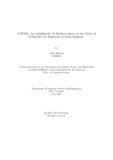| dc.description.abstract | Explainable AI (XAI) techniques are essential for comprehending machine learn-
ing model predictions in a variety of fields, including healthcare. In this study, we
highlight XOPSIS, a newly developed XAI method built on the TOPSIS score and
intended to offer thorough justifications for gradient boosting models. We com-
pare the performance of XOPSIS with two established XAI techniques, LIME and
SHAP, using a comprehensive dataset encompassing different domains, including
maternal health records, the benchmark Iris dataset, and the benchmark breast
cancer dataset. Our findings demonstrate significant similarities between XOPSIS
and LIME in generating explanations and consistently identifying the most influen-
tial features contributing to the model’s predictions. In addition, by utilizing SHAP
values, we acquire a comprehensive comprehension of the model’s behavior and the
unique contributions of each feature to the predictions. The significance of our pro-
posed approach lies in its ability to enhance interpretability in machine learning
models, enabling stakeholders to make informed decisions across various domains.
While we showcase the effectiveness of XOPSIS in maternal health risk prediction,
the benchmark Iris dataset, and breast cancer diagnosis, its applicability extends to
diverse domains such as finance, cybersecurity, and customer behavior analysis. The
flexibility and generalizability of XOPSIS make it a valuable tool for understanding
the underlying factors driving model predictions. In addition to the maternal health
records, the benchmark Iris dataset, and the breast cancer dataset, we also apply
XOPSIS to the Car Acceptability dataset, further expanding its applicability across
diverse domains. By including this dataset, we demonstrate the versatility of XOP-
SIS in providing comprehensive explanations for machine learning models in various
contexts. Furthermore, future studies should focus on the practical implementation
of XOPSIS in different domains, evaluating its effectiveness in real-world scenarios,
and assessing its impact on decision-making processes. Furthermore, exploring the
integration of XOPSIS in various industries and applications can provide valuable
insights into the interpretability and transparency of machine learning models. By
advancing XAI techniques like XOPSIS, we can foster trust, accountability, and
widespread adoption of AI technologies in diverse fields, ultimately benefiting both
industry practitioners and end-users. The continued development and refinement
of XOPSIS and similar XAI methods will contribute to the responsible and ethical
use of AI, promoting transparency and understanding in complex machine learning
models. | en_US |

